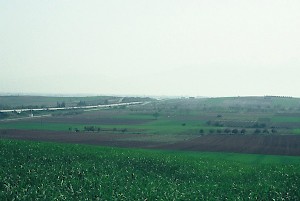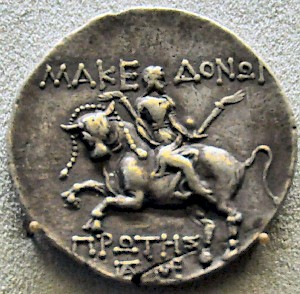Macedonia (8)
Q207497Macedonia: ancient landscape and state, situated in the Former Yugoslav Republic of Macedonia and northern Greece, best known because its king Alexander the Great (r.336-323) conquered the Persian Empire and inaugurated a new period in Greek history.
The Roman age
Antigonus' adopted son Philip V really believed that he was as powerful as his namesake Philip II, and made a disastrous mistake when in 215 he signed a treaty with Hannibal Barca, the Carthaginian general who was successfully fighting against Rome. Philip promised that he would attack Rome's Illyrian province, and Hannibal hoped that this would distract Rome's attention from the Italian theater of operations. This was a serious mistake. The Romans were able to ward off the Macedonian attack, and - worse - were able to turn to the tables when the Aetolian League became their ally. Other Greek towns and states followed, and it soon became clear that Philip would never be able to help Hannibal. In 205, the Peace of Phoenice put an end to the First Macedonian War.note
When Hannibal had been defeated, Rome wanted revenge. During the Second Macedonian War (200-196), Philip witnessed the destruction of all that he owned. In 197, the Roman legions of Flaminius defeated the Macedonian phalanx in the battle of Cynoscephalae: a severe blow for the prestige of Macedonia. Nor was this the end of Philip's humiliation. The Romans retreated their troops and created a power vacuum that the Seleucid king Antiochus III the Great could not leave empty. This gave Rome the motive to invade the Aegean region again, and this time, Philip was even forced to act as ally.

His son Perseus inherited a strained relation to Rome, but was able to gain support in Greece. The Romans, however, had decided to isolate and destroy him. In 171, war broke out, and in the third year, Lucius Aemilius Paullus defeated Perseus in the Battle of Pydna. Macedonia was cut into four republics, with Amphipolis, Thessaloniki, Pella, and Heraclea in Lyncestis as capitals. The final blow came in 148, when the Romans finally annexed Macedonia, added southern Illyria (capital: Apollonia), and transformed it into a tax-paying province. Greece followed two years later.

The new province was developed carefully. A road, the Via Egnatia, was built and connected Apollonia with the capitals of the former republics. Later, this road was continued to Byzantium. Macedonia was important, because it protected the wealthy Aegean provinces against raids from northern tribes. At the same time, Macedonia was midway between Italy and rich territories of the east, and it comes as no surprise that several important battles during the Roman civil wars were fought in this province: in the battle of Pharsalus, Julius Caesar defeated his enemy Pompey the Great (48), and in the battle of Philippi, Mark Antony and Octavian defeated the assassins of Caesar, Brutus and Cassius (42).
During the Roman empire this giant province was divided. Once the country south of the Danube had been pacified, Moesia and Thrace became independent. During the reforms of the reign of Diocletian (r.284-305), Macedonia received the rank of diocese. In the territory of the old province, the new provinces Macedonia I (capital: Thessalonica), Macedonia II (Stoboi), Thessalia (Larisa), and Epirus Nova (Dyrrhachaeum) were created, to which Achaea and Creta were added.
After the battle of Adrianople, in which the Tervingi defeated the Roman emperor Valens (378), the invaders were allowed to settle in Macedonia, which suffered badly. Still, Thessalonica remained an important city, guarded by the Second Flavian Legion Constantia, and Macedonia continued to export cereals and timber. The emperor Justinian (r.527-565) repaired many buildings and forts, but was unable to prevent that at the end of the sixth century, Macedonia was invaded by the Avars and by Slavic tribes, who reached Thessaloniki, were repelled, returned, and finally settled down.